Cleric 101: A Beginner’s Guide to Playing the Divine
A priest stood before a towering heap of kindling, a young woman bound to a stake amidst the tinder. The beads of sweat on the priest’s pallid skin reflected the light of hundreds of torches carried by the throng that surrounded him. He held aloft a wooden holy symbol, bearing the sign of Lathander the Morninglord. He bellowed over the noise of the crowd.
“People of Womford, I stand before you with the path to redemption! For weeks you have been deceived by a witch pretending to be one of your own. For weeks she has corrupted your youth, tempted your innocent, defiled your most holy! You shall stand for it no longer. Tonight, with the grace of Lathander the Morninglord, I cast her into the fires of the Nine Hells!”
The priest snatched a burning torch from one of the throng and turned to the woman as the crowd roared in mindless approval.
Then came a footfall. A heavy squelch of an armored boot into mud. Then another, and another, drowning out the noise of the crowd like the thunderous steps of a giant. The crowd parted down the middle and turned in awe to look at the stocky halfling woman that strode through their midst. Her silver armor gleamed in the torchlight, and the golden icon of Lathander around her neck seemed radiant like the sun.
She locked eyes with the priest that stood before her and steeled her focus, gripping tightly to the spell of thaumaturgy that magnified her every sound. Then she spoke. She spoke with the force of a hurricane.
“False priest! I stand before you, a true servant of the Morninglord whose name you profane. I see how you have ensnared the minds of these innocent people. I see how you would use innocent women as your scapegoats. I see your evil, and I rebuke it.” She held aloft her holy symbol and roared. “Vampire! In the name of Lathander, I turn thee!”
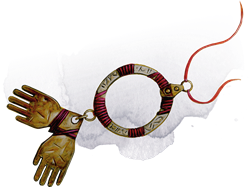 You are playing a cleric, an emissary of the gods. Your divine connection grants you great power, but the many spells and options available to you can be daunting. While the most important part of Dungeons & Dragons is playing your character in a way that’s fun for you and your fellow players, there are certain basics of how to play a cleric that every player should know so that you can help your party in combat.
You are playing a cleric, an emissary of the gods. Your divine connection grants you great power, but the many spells and options available to you can be daunting. While the most important part of Dungeons & Dragons is playing your character in a way that’s fun for you and your fellow players, there are certain basics of how to play a cleric that every player should know so that you can help your party in combat.
This guide will cover the basics of clericdom, walking you through the first 5 levels of playing a cleric and focusing on how to choose spells and other class features. There are an overwhelming amount of options to choose from, and the core rulebooks don’t explain what is a good option or why, or what options are good in what situations. This guide will clear up some confusion.
Quick Build Expanded: Building Your Cleric
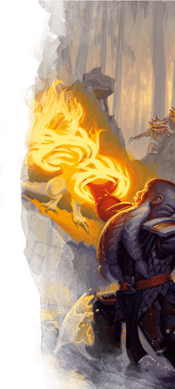 The Quick Start guidelines in the Player’s Handbook are a good place to start building your character, but don’t go far enough for most new players. This Expanded Quick Start guide assumes you’re using the D&D Beyond Character Builder, which also includes helper text for new players.
The Quick Start guidelines in the Player’s Handbook are a good place to start building your character, but don’t go far enough for most new players. This Expanded Quick Start guide assumes you’re using the D&D Beyond Character Builder, which also includes helper text for new players.
- Under “Character Preferences,” turn off “Playtest Content” and “Show Unarmed Strike”
- Choose your Race. Any race can be a useful cleric, but races that increase your Wisdom score, such as hill dwarves, wood elves, humans, and half-elves, are good mechanical choices.
- Choose Cleric as your class.
- Choose skills that fit who you want your character to be.
- Decide what role you want to fill in the party. This step involves a lot of thought, so let's break it down.
What Kind of Cleric Are You?
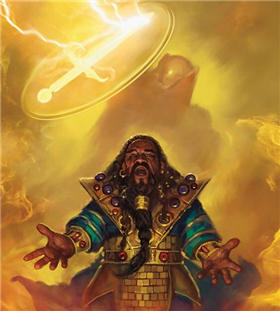 If you’re feeling overwhelmed by options, you’re not alone. Cleric is one of the most multifaceted classes in the game, boasting an impressive seven subclasses (“Divine Domains”) in the Player’s Handbook alone. Consider what role you want to fill in your adventuring party before choosing your Divine Domain and which god you want to follow. Do you want to be an offensive character, using spell and steel to destroy your enemies? A tank, protecting allies from harm on the front lines? Or a support character, healing your allies and improving their combat abilities? (Also, note that while this guide uses the terms Offense, Tank, and Support as shorthand, no part of D&D actually refers to characters in this way. This is just a simple way to classify roles in the average party.)
If you’re feeling overwhelmed by options, you’re not alone. Cleric is one of the most multifaceted classes in the game, boasting an impressive seven subclasses (“Divine Domains”) in the Player’s Handbook alone. Consider what role you want to fill in your adventuring party before choosing your Divine Domain and which god you want to follow. Do you want to be an offensive character, using spell and steel to destroy your enemies? A tank, protecting allies from harm on the front lines? Or a support character, healing your allies and improving their combat abilities? (Also, note that while this guide uses the terms Offense, Tank, and Support as shorthand, no part of D&D actually refers to characters in this way. This is just a simple way to classify roles in the average party.)
Offense
Cleric might seem an odd choice of class if you want to deal serious damage, but clerics can stand toe-to-toe with fighters and paladins on the battlefield, if played properly. If you want to play an offensive cleric, consider choosing the Light domain, which grants you the power to smite your enemies with fire from afar, or the Tempest domain, which empowers your weapons with the storm’s fury.
With your DM’s approval, you can also choose the Death domain, allowing your very touch to befoul life. If you want to play the cleric of a god of death, like the Raven Queen, it’s recommended you play Support and choose the Grave domain instead, which isn’t as explicitly evil as the Death domain.
Tank
Some clerics wish to mitigate damage from the front lines, rather than healing their allies later. As a Tank, you don heavy armor and conjure magical wards to shield your enemies. As a cleric of the Forge domain (from Xanathar’s Guide to Everything), you can bless weapons and armor in order to protect yourself and others, while clerics of the Nature domain can call upon the elements to protect their allies from harm and beseech the natural world for aid.
Finally, clerics of the War domain straddle the line between offensive fighter and defensive protector, but they lean more towards the role of Tank; their heavy armor and accurate blows make them a high-value target, causing them to absorb blows that would otherwise go to more vulnerable allies.
Support
Most clerics fall easily into the Support category, and you have many options to choose from if you want to help keep your party members alive, both by warding away enemies and healing allies. The Arcana domain (from the Sword Coast Adventurer’s Guide) helps you break enchantments on your allies and ward away supernatural threats. The Grave domain (from Xanathar’s Guide to Everything) helps you stave death away from your allies as a sentinel at death’s door. The Knowledge domain grants you worldly knowledge and allows you glimpses of wisdom beyond your ken. The Life domain is a straightforward subclass that empowers your healing spells. Finally, the Trickery domain allows you to beguile foes and move about unseen.
- After selecting your subclass, place your highest ability score in Wisdom and your second highest ability score in either Strength, Dexterity, or Constitution. Choose Strength if you're playing Offense, Dexterity as a Support, or Constitution as a Tank. As a Tank, you'll also want a Strength score of 15 in order to wear heavy armor without penalty.
- Choose a background that fits your character concept. This is a chance for you to be creative and break free of cleric stereotypes!
- Finally, determine your equipment. For an easy selection, click on “EQUIPMENT” when promoted to “Choose EQUIPMENT or GOLD”. Pick whatever equipment suits your vision of your character. While a warhammer is generally better than a mace and chainmail is generally better than your other armor options, it’s hard to go wrong here.
A Cleric in Combat
As a cleric, your most powerful tool is your ability to cast spells. While your weapons and armor may be impressive (especially in a Tank or Offense role), your spellcasting is still number one. Clerics know all of the spells on their spell list, plus any spells granted to you by your domain, but can only prepare a certain number of them per day. You can change your prepared spells (not including cantrips) whenever you complete a long rest! These sample spell progressions will help you get started, and are a great template to start swapping spells out from if you need more situational abilities.
Finally, remember that you can only prepare a number of spells equal to your Wisdom modifier plus your level in this class. (See the “Spellcasting” section of the cleric class in the Player’s Handbook if you need more information.) This spell selection sheet assumes you have a Wisdom modifier of +2 at 1st level. If it’s +3 instead, you can prepare an extra spell of your choice in addition to what's suggested here! Finally, be aware of the Domain Spells granted to you by your Divine Domain. These spells are always prepared, and can help round out your arsenal. If this list suggests a spell that you have as a Domain Spell, just pick another spell to prepare instead.
Offense
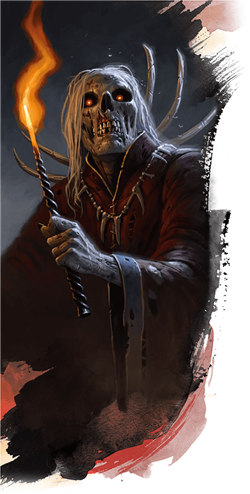 Clerics have relatively few offensive options, but those you do have are quite potent. Your most powerful spells only target single creatures, so you should spend encounters with many weak enemies in the front lines, conserving spell slots by using your weapon instead.
Clerics have relatively few offensive options, but those you do have are quite potent. Your most powerful spells only target single creatures, so you should spend encounters with many weak enemies in the front lines, conserving spell slots by using your weapon instead.
At 1st level, learn three cantrips of your choice, including sacred flame. Sacred flame will let you deal damage from range when you can't or don't want to use spell slots.
Also at 1st level, prepare the bless, command, and guiding bolt spells. Bless will help your attacks and your allies' attacks hit more often. Guiding bolt deals incredible damage and makes it easier for your allies to deal with enemies that survive the attack. Command will allow you to set up easy attacks or help you escape risky situations if you’re overwhelmed.
At 2nd level, prepare the inflict wounds spell. This spell is weaker than guiding bolt, but it lets you cast spells in melee range without incurring disadvantage on the attack roll.
At 3rd level, you gain access to 2nd-level spells! Remember that you can cast spells like guiding bolt in higher level spell slots to increase their power. Prepare the spiritual weapon spell. You can cast this spell as a bonus action, allowing you to also make an attack with your melee weapon or cast a cantrip like sacred flame with your action. (Remember that you can’t cast two leveled spells in the same turn; if you cast a leveled spell as a bonus action, you can only use your action that turn to cast a cantrip, not another leveled spell.)
At 4th level, use your Ability Score Increase to improve your Wisdom modifier to +3 (or possibly +4, depending on your starting ability scores). Also, learn another cantrip of your choice.
Also at 4th level, prepare the cure wounds and hold person spells. Cure wounds is a good spell to have in a desperate situation, but you can’t make use of it as effectively as a Life cleric. Hold person is an excellent spell even used offensively, as attacks against an adjacent paralyzed creature are automatic critical hits. Consider casting spiritual weapon, then on your next turn using your action to cast hold person on a creature, then using your bonus action to attack it with your spiritual weapon!
5th level marks a major increase in power for you, since you gain access to 3rd-level spells. Unfortunately, most 3rd-level cleric spells are defensive or support-focused. You’ll have to rely on your domain spells for offensive power here. (The Light domain grants you fireball!) Prepare the bestow curse spell. This flexible spell allows you to improve your damage against one creature or make it harder for the creature to hit you.
Tank
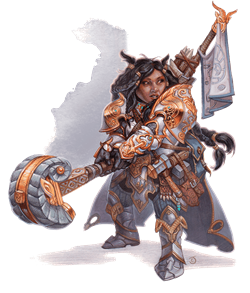 You want to protect your allies by taking hits instead of them. As such, you want to be on the front lines in the heaviest armor and shield imaginable, making it hard for enemies to ignore you and just as hard for them to hit you. Your spells are focused on proactively protecting your allies, rather than healing them after they take damage.
You want to protect your allies by taking hits instead of them. As such, you want to be on the front lines in the heaviest armor and shield imaginable, making it hard for enemies to ignore you and just as hard for them to hit you. Your spells are focused on proactively protecting your allies, rather than healing them after they take damage.
At 1st level, learn three cantrips of your choice, including resistance. Resistance will help you bolster an ally’s next saving throw if cast right before a fight begins.
Also at 1st level, prepare the bane, command, and inflict wounds, spells. Bane makes it hard for enemies to hit with their attacks. Command allows you to halt an enemy attacking your weaker allies. Finally, inflict wounds lets you deal serious damage in melee combat, since you always want to be on the front lines.
At 2nd level, prepare healing word. Since you can cast this spell as a bonus action, you can heal an ally from range and still make an attack on the same turn.
At 3rd level, you gain access to 2nd-level spells! Remember that you can cast spells like healing word in higher level spell slots to increase their power. Prepare warding bond, which allows you take half of the damage that a chosen ally takes, allowing you to help keep a weaker damage dealer in the fight for longer.
At 4th level, use your Ability Score Increase to improve your Wisdom modifier to +3. If your Wisdom modifier is already +3, take the Sentinel feat to make yourself a better melee defender. Also, learn another cantrip of your choice.
Also at 4th level, prepare blindness/deafness (and aid if you increased your Wisdom score this level). Aid allows you to efficiently increase your allies’ durability by granting them temporary hit points. Blindness/deafness can severely incapacitate an enemy by blinding it. One serious downside of being blinded is that it can no longer target creatures with effects that require it to see the creature, such as most spells. Enemy spellcasters hate being blinded!
5th level marks a major increase in power for you, since you gain access to 3rd-level spells. Prepare spirit guardians, allowing you to make it difficult and painful for enemies to move past you.
Support
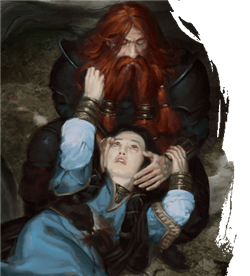 This is the role most people think of when considering playing a cleric. One thing you need to know before playing Support, however, is that your healing spells will almost never outpace enemy damage. In combat, you’re most effective while debuffing enemies or doing damage from range. While it may seem like you’re treading on Offense’s toes, understand that when it comes to D&D, the best defense is a good offense. As your team’s Support, only use your healing in combat when absolutely necessary to keep allies alive; otherwise, save it for after a fight is over.
This is the role most people think of when considering playing a cleric. One thing you need to know before playing Support, however, is that your healing spells will almost never outpace enemy damage. In combat, you’re most effective while debuffing enemies or doing damage from range. While it may seem like you’re treading on Offense’s toes, understand that when it comes to D&D, the best defense is a good offense. As your team’s Support, only use your healing in combat when absolutely necessary to keep allies alive; otherwise, save it for after a fight is over.
At 1st level, learn three cantrips of your choice, including spare the dying. Spare the dying will help you save allies (or NPCs) when you are out of spells.
Also at 1st level, prepare the cure wounds, guiding bolt, and shield of faith spells. Cure wounds is your bread and butter, allowing you to efficiently heal allies. If you’re a Life cleric, take healing word instead, since your Disciple of Life feature shores up the low number of hit points this spell usually restores. Guiding bolt will help you deal some damage from the back ranks in a pinch. Shield of faith lets you improve your squishy allies’ Armor Class, making them less likely to take damage.
At 2nd level, prepare protection from evil and good if your campaign looks like it will include supernatural foes like undead and aberrations. Otherwise, prepare the more generally useful buff spell bless.
At 3rd level, you gain access to 2nd-level spells! Remember that you can cast spells like cure wounds in higher level spell slots to increase their potency. Prepare lesser restoration, which ends one hazardous condition such as poison or paralysis affecting a creature.
At 4th level, use your Ability Score Increase to improve your Wisdom modifier to +3 (or possibly +4, depending on your starting ability scores). Also, learn another cantrip of your choice.
Also at 4th level, prepare enhance ability and hold person. Enhance ability is a flexible spell that can help allies in combat, exploration, and interaction scenarios. Hold person is a generally powerful spell, made even more powerful when you cast it while far away from the enemies as a Support character should be, since breaking your concentration is difficult if enemies can’t reach you.
5th level marks a major increase in power for you, since you gain access to 3rd-level spells. Prepare beacon of hope, allowing you to maximize the healing done to your allies. You can also change out one of your prepared spells for mass healing word, which will help you restore hit points to many allies at once.
Making your Cleric your Own
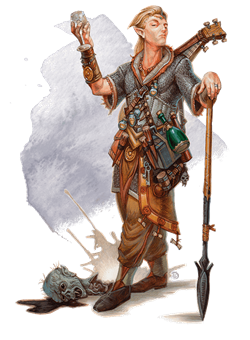 Playing a character in D&D isn’t like playing a character in League of Legends or building a deck in Hearthstone. There’s no one right build or one right way to play—especially because the way you play your character depends so much on your character’s personality!
Playing a character in D&D isn’t like playing a character in League of Legends or building a deck in Hearthstone. There’s no one right build or one right way to play—especially because the way you play your character depends so much on your character’s personality!
If you followed these guidelines to a T and created an effective-but-generic cleric, I challenge you to go back and change one thing, one spell, one ability score and make them stand out from the crowd. Use the mechanics of the game to make a unique and interesting character, otherwise I swear you will hear my voice chanting generic cleric in your mind every time you cast a spell.
Happy Healing!
 James Haeck is the lead writer for D&D Beyond, the co-author of the Critical Role Tal'Dorei Campaign Setting, and writes as a freelancer for Wizards of the Coast, the D&D Adventurers League, and Kobold Press. He lives in Seattle, Washington and plays as the dutiful Nature cleric to his two conjured beasts, Mei and Marzipan. You can usually find him wasting time on Twitter at @jamesjhaeck.
James Haeck is the lead writer for D&D Beyond, the co-author of the Critical Role Tal'Dorei Campaign Setting, and writes as a freelancer for Wizards of the Coast, the D&D Adventurers League, and Kobold Press. He lives in Seattle, Washington and plays as the dutiful Nature cleric to his two conjured beasts, Mei and Marzipan. You can usually find him wasting time on Twitter at @jamesjhaeck.








-
View User Profile
-
Send Message
Posted Mar 21, 2018I personally really liked this article. I hope an article like this for the wizard class come out.
-
View User Profile
-
Send Message
Posted Mar 21, 2018Love it, only real thing i feel could be pointed out for tank and support is if they plan at anypoint on using plate armor they may want to still make their second highest stats strength still as that needs str 15 to even consider using plate.
Apart from that could I please request one of these for druids. I have a new player to dnd coming in and druid is one of those classes that seems to cause difficulties to new players due to complexity.
-
View User Profile
-
Send Message
Posted Mar 21, 2018Your description of the rules over casting more than one spell per turn isn't quite correct. Sorry to nitpick but it works thus - if you cast a spell using a bonus action, then any other spell cast can only be a cantrip with a casting time of one action. This is slightly different from "if you do cast two spells, one of them has to be a cantrip", but the differences can be significant at times.
-
View User Profile
-
Send Message
Posted Mar 21, 2018I too, hope for a similar article concerning wizards. I found this one very illuminating.
-
View User Profile
-
Send Message
Posted Mar 21, 2018D&D Beyond has been killing it with these wonderful articles. Thank you!
-
View User Profile
-
Send Message
Posted Mar 21, 2018Please do one for the rest of the classes!
-
View User Profile
-
Send Message
Posted Mar 22, 2018Thank you for a well written and informative article!
-
View User Profile
-
Send Message
Posted Mar 22, 2018Really great article! I feel like author James Haeck and DnDBeyond are just killing it with all the awesome articles they’re putting out lately! Keep up the incredible work.
-
View User Profile
-
Send Message
Posted Mar 22, 2018The cantrip spare the dying is incredibly bad isn't it? It's exactly the same as a Healer's Kit, which cost 5gp for 10 uses. Even without the Kit it's just a DC 10 Wisdom (Medicine) check to accomplish the same task. I really don't understand why the spell doesn't just take a bonus action and/or has a range. I'd favor giving it both. It would still be very bad.
Very nice guide nonetheless! Very good read!
-
View User Profile
-
Send Message
Posted Mar 22, 2018-
View User Profile
-
Send Message
Posted Mar 22, 2018Really? I was stuck on that part. Thank god you explained it for me.
-
View User Profile
-
Send Message
Posted Mar 22, 2018Really enjoyed this article and the rest of the recent content! Please keep it up, I'm loving having D&D Beyond as my internet hub for D&D!
-
View User Profile
-
Send Message
Posted Mar 24, 2018Thanks for this. This is what's been missing from D&D's most recent website. We used to get this kind of article on the old D&D site (in my 3.5 days) or in Dragon or Dungeon magazines. Man, I've missed it. You have taken steps toward filling that void, and good lord do I appreciate it!
-
View User Profile
-
Send Message
Posted Mar 26, 2018Thanks for the article, I using this advise along with another I found making unstoppable Healing Cleric with a second class of Warlock with a Divine patron. Looking forward to your additional class reflections.
-
View User Profile
-
Send Message
Posted Mar 27, 2018Great article!
-
View User Profile
-
Send Message
Posted Mar 29, 2018-
View User Profile
-
Send Message
Posted Apr 3, 2018-
View User Profile
-
Send Message
Posted Jul 9, 2018Except that you can't switch out cantrips once they're chosen...
-
View User Profile
-
Send Message
Posted Aug 28, 2018Just a query on a point of confusion for me.
My cleric is level 5 with a Wisdom of 20 Mod +5.
Thus I can prepare 10 spells, correct?
Question does that mean my cleric can cast 10 1st level spells or 10 2nd level spells?
I guess what I am asking (trying to Clarify) is that do the spell slots equal Level + Wisdom Modifier?
How does that work at higher levels?
-
View User Profile
-
Send Message
Posted Aug 29, 2018You can prepare 10 spells, total. So between all the 1st, 2nd, and 3rd level spells available to you as a cleric, you can only prepare 10.
Once you have those spells prepared, you still have to use your spell slots to cast them. The number of spell slots you have at any given level are shown on the Cleric Table. As a 5th level cleric, you have four 1st-level spell slots, three 2nd-level spell slots, and two 3rd-level spell slots.
Imagine it like you have a deck of cards. That deck is all of the cleric spells that exist. If you can prepare 10 spells, that means you can draw 10 cards from the deck. When you use a spell slot to cast a spell, you play the card to cast it, mark off a spell slot, and then put the card back into your hand. Using a spell slot doesn't change the fact that you still have the spell slot prepared; you could use all four 1st-level slots to cast cure wounds, if you wanted. Once you're out of spell slots, you just can't play any more cards from your hand.